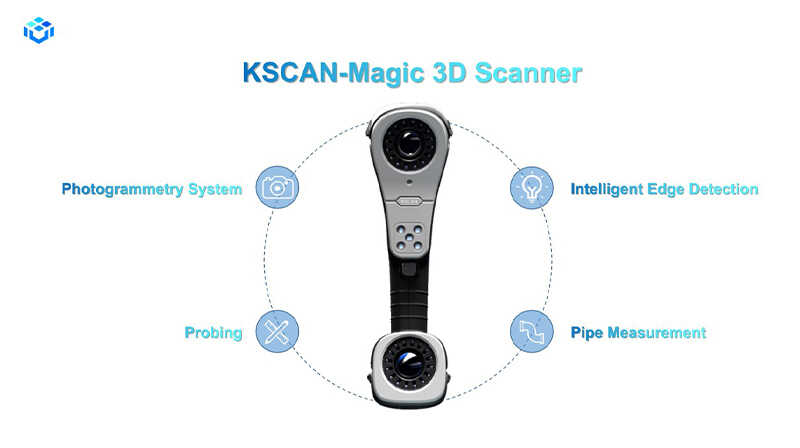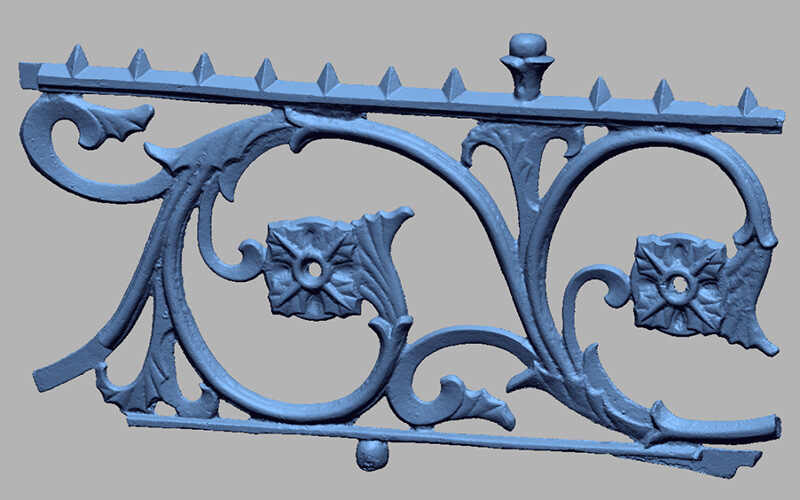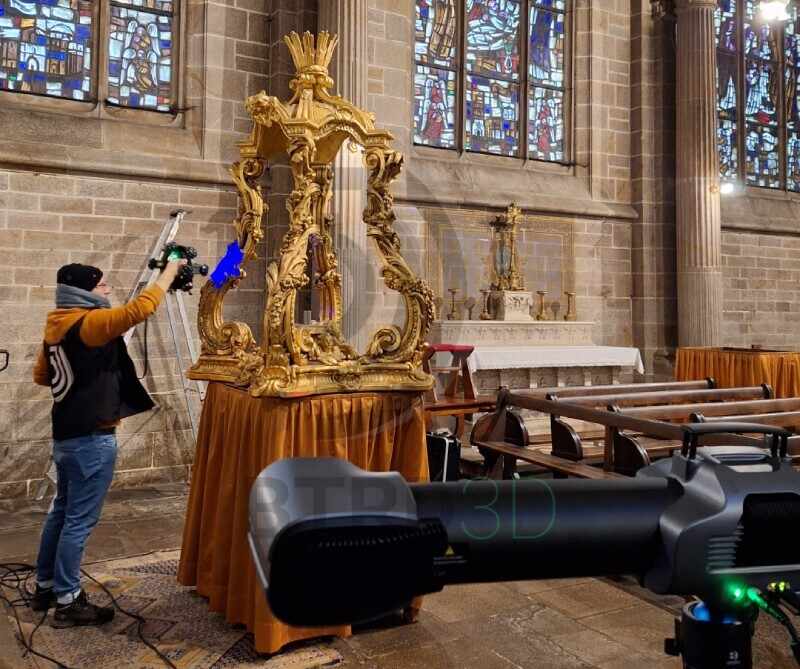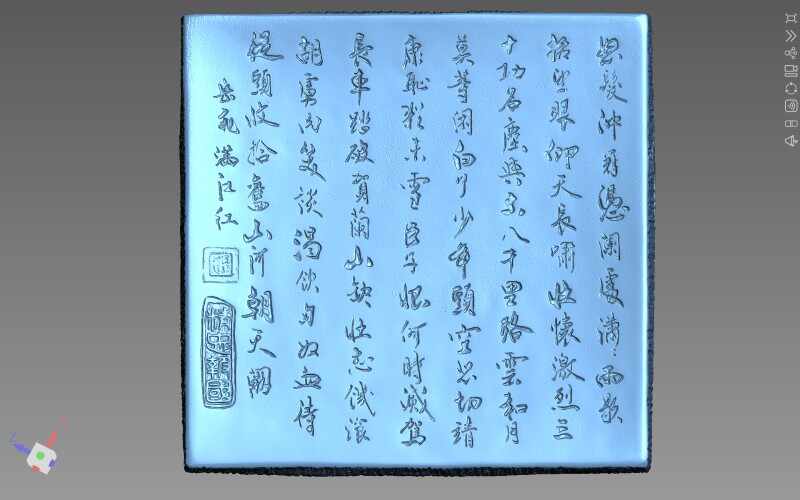過去の保存:文化遺産に対する3Dスキャン技術の影響
誰もが知っているように、文化的遺物を保存し研究する仕事は常に過去と歴史に焦点を当てていますが、その究極の目的は現在および現代のニーズに応えなければなりません。急速なデジタル開発のこの時代に、高度なテクノロジーは、私たちが文化遺産を保護し、渡す方法を静かに変えています。 3Dデジタル化、これらの技術の中で、大きな貢献をしています。
文化遺産保存の重要性
文化的遺物は、素晴らしい文明の本質を持ち、歴史文化を継承し、国民の精神を維持します。彼らは私たちの先祖から私たちに残された貴重な遺産です。これらの遺物と文化遺産は、その文明コードと歴史的記憶が刻まれた、A国の遺伝子と血統を保持しています。これらの遺物が損傷または失われたとき、私たちは非常に貴重な知識と文化遺産を失います。それが、これらの宝物を維持することが歴史的記憶だけでなく、文化的継続のために不可欠である理由です。
文化の保存における3Dスキャン技術の役割
3Dスキャン 形状、パターン、色を含む高精度でアーティファクトの詳細をキャプチャできるようにします。非接触3Dスキャンテクノロジーを使用することにより、これらの貴重な遺物に害を及ぼすリスクが最小限に抑えられます。結果として生じる3Dモデルは、研究目的で役立つだけでなく、貴重な教育リソースとしても役立ちます。彼らは、世界中の人々がVR/ ARを通じて遺産を探求し、世界のどこからでもこれらの宝物へのアクセスを提供することを可能にします。さらに、3Dスキャンは、専門家に貴重な洞察を提供することにより、文化遺産の状態について専門家に提供し、科学的原則に基づいた正確な修復プロセスを導くことにより、文化を維持する上で重要な役割を果たします。
1。 アーチファクト R和解
アーティファクトの修復中、3Dスキャンテクノロジーを利用して、回復の専門家がアーティファクトに元の構造と損傷の範囲を理解するのを支援する測定値を提供します。測定された3Dデータは、修復戦略の開発に役割を果たします。
たとえば、SCANOLOGYが助けてくれました 歴史的なサイトのフェンスパネルを保存して強化します そので KSCAN -マジックポータブル3Dレーザースキャナー。高い-正確なスキャンを通じて、彼らは修復努力のために重要な情報を提供するパネルの特徴を細心の注意を払って記録しました。このプロセスは、アーティファクトの元の外観を大幅に保存しました。


2。 Rの作成rleaplication
3Dスキャンテクノロジーは、修復において重要な役割を果たすだけでなく、アーティファクトレプリケーションの科学的基盤を提供します。高精度3Dスキャン機器を使用することにより、専門家はアーティファクトの正確なデジタルモデルを作成できます。その後、3Dプリンターで使用して、オリジナルに正確な複製を生成できます。このプロセスは、特にオリジナルが壊れやすい、または損害のリスクがある場合、貴重な文化遺産を維持するために不可欠です。レプリカはディスプレイと教育に使用できますが、オリジナルは安全に保たれます。
を含むプロジェクトで セントアンダウレイの彫刻、SCANOLOGYの トラックスカン-シャープ光学3D測定システム そして Ireal M3 3Dカラースキャナー 極めて重要な役割を果たしました。 最大0.025 mmの精度で、TrackScan - Sharpは物理的な接触なしに繊細な機能を正確に再現し、アーティファクトの完全性を維持します。 Trackscanの青いレーザーは、さまざまな表面やサイズにシームレスに適応し、壮大なアーチから2mm未満の小さな装飾品まですべてを処理しました。さらに、高度な3Dマッピングソフトウェアと組み合わされたIreal M3は、多様な材料にわたって真の色と詳細なテクスチャをキャプチャすることができました。


3Dスキャンソリューションにより、忠実な複製と文化的アーティファクトの保護が可能になり、これらの非常に貴重な歴史の断片が、今後の研究、教育、および感謝のためにアクセスできるようにします。
3。 デジタルドキュメント
デジタルドキュメントは、文化遺産の保存に不可欠であり、博物館や機関がアーティファクトの詳細なアーカイブを作成し、次元、テクスチャ、色を捉えることができます。これらのデジタルレコードは、カタログと研究だけでなく、オリジナルへの潜在的な損傷に対する安全なバックアップとしても役立ちます。彼らは、将来の世代が正確で永続的な表現へのアクセスを可能にし、グローバルな研究コラボレーションのためにリモートアクセスを提供します。
SCANOLOGYはこの分野で役立ちました。 Alibabaの「Gifts From Counties」プログラムと共同で、SCANOLOGYはKSCAN - Magic Portable Scannerと3Devokマッピングソフトウェアを使用しました。 yi lackerwareをドキュメントします、パゴダボックスやワインポットなどの従来のアイテムの詳細な3Dモデルを作成します。

同様に、Nimbletrack 3Dシステムは、0.025 mmの精度で複雑な石の彫刻を保持し、接触またはマーカーなしで複雑な救済の詳細と碑文をキャプチャしました。従来の方法に代わる非侵襲的で永続的な代替品を提供します。これらのデジタルアーカイブは、テクノロジーと文化的保存をブレンドし、アクセシビリティを向上させ、これらの宝物が耐えることを保証します。


Cclusion
現代世界の複雑さをナビゲートするにつれて、文化遺産の保存は新しい重要性を引き受けます。伝統とテクノロジーの相互作用は、過去を保護するための私たちのアプローチを再構築し、貴重な遺物が保護されているだけでなく、将来の世代にもアクセスできるようにすることを保証します。 3Dスキャンなどの革新的な方法を通じて、私たちは文化的な宝物を文書化するだけでなく、共有された歴史のより深い理解を促進しています。
成功した修復、複製、デジタルドキュメントの例は、この分野のテクノロジーの変革力を示しています。のような組織 SCANOLOGY 高度なツールを利用して、最も繊細なアーティファクトでさえ時間のテストに耐えることができるようにして、最前線にいます。
最終的に、文化遺産を保存することは義務以上のものです。それはアイデンティティと継続性のお祝いです。テクノロジーを採用することにより、現在と未来の文化的景観を豊かにしながら、先祖の遺産を尊重することができます。私たちが先を見据えて、私たちの過去を覚えているだけでなく、世界中の多様な文化をより深く理解するために、これらの進歩を活用することを約束しましょう。そうすることで、私たちはすべての人にとってより豊かで、よりつながりのある未来を確保します。



















 Compare Productos
Compare Products
Compare Productos
Compare Products
 すべての製品
すべての製品 



















